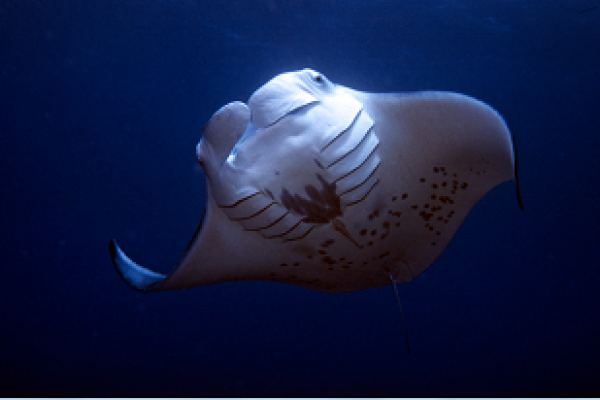 Common name:
Common name:
Manta ray
Scientific Name:
Manta birostris, Manta alfredi
Critter contributor:
Jeff Kuwabara, UHM MOP Coordinator
A portrait of tranquility, the manta ray undulates gently through the water. These elegant filter feeders are easily identified by their wing-like pectoral fins, gaping mouths, and diamond-shaped body. There are two species of manta ray; the giant (M. birostris) and the reef (M. alfredi). The former is distinguishable by its greater size and caudal thorn, which is widely believed to be a vestigial indicator of its relation to the stingray. Individual rays can be identified by unique spot patterns. These magnificent creatures also possess the largest brains of any fish studied thus far; they have demonstrated the capacity to differentiate between objects, retain memories, and seemingly recognize themselves in mirrors!
Mantas are the world’s biggest rays and the only vertebrate to possess three paired appendages (pectoral fins, gills, and cephalic lobes). This last is used primarily for feeding, pushing water and plankton into the maw of the ray. In addition to these appendages, the manta ray employs a variety of tactics to snatch up the most food. Manta rays feed by creating a sort of funnel to lead prey into their mouths, often somersaulting and ‘barrel-rolling’ through the water to scoop up a greater number of plankton.
It is difficult to establish a clear habitat occupied by the manta ray, as they are scattered around the world and thrive under a wide range of conditions. Manta rays can be found in tropical, subtropical, and temperate waters anywhere from 10 to 1000 meters. Additionally, mantas are solitary creatures, aggregating only occasionally following long migratory periods to feed and mate. These are slow-growing fishes with a low reproductive rate; typically, females will give birth to only one pup every two to three years. This slow population growth is a contributor to the overall decline in the number of manta rays. Commercial fishing also presents a threat to these serene giants; not only are they actively hunted for their gill rakers, which are much in demand, but manta rays are frequently bycatch. The dwindling population of mantas has earned them a label of ‘vulnerable’ on the IUCN Red List. If you’d like to learn more and help to secure the future of these remarkable creatures, you can visit https://www.mantatrust.org/.
